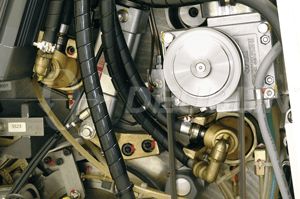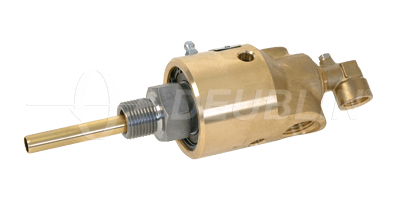Up-to-date rotating unions for modern printing machines
They are concealed from view, but the functionality of modern printing machines would be unthinkable without them: Rotating unions.
Whether it is a sheet-fed offset, web-fed offset or a gravure printing machine, rotating unions are the link between the rotating rollers and the pipe and tube connection to the heater or cooling circuit for the tempering of colour distributing rollers, printing colour units or dampening systems.
Experts recognize them easily by the brass-coloured housing, if the electronic component layer on the side of the machine is moved aside.
Tempering and constant temperature maintenance is generally an essential basis for equal, reproducible quality at the highest machine speeds. This is also the key to reducing start-up and production waste, which is a substantial cost factor.
 What makes the “rotating union” component so important for this task?
What makes the “rotating union” component so important for this task?
As it guides the tempering medium in or out of the rotating part, its technology and its development level have a large influence on the overall efficiency of the machine:
- Primarily in the form of optimized flow channels and lower turbulence, synonymous with an even temperature profile and increased quality with reduced wastage.
- Secondarily in terms of the necessary energy usage, as current rotating union models only represent low losses in pressure and likewise a low friction coefficient, with the result that pump and motor output can be reduced. As well as the cost advantage, less energy usage also means a CO2 reduction, which is an important aspect nowadays.
Moreover, in this case the tertiary aspect shall not ignored: the service life of a rotating union.
 This highlights the difference between branded goods and cheap products, quickly separating the “wheat from the chaff”.
This highlights the difference between branded goods and cheap products, quickly separating the “wheat from the chaff”.
It is an undisputed fact that every rotating union that is based on the principle of a “balanced mechanical seal” represents a wear part, because although the slip rings are lubricated, they are subject to wear and tear over time.
It is not difficult to notice a resulting cost driver: How often (or seldom) must the rotating unions be replaced? Can the rotating unions be replaced as part of a regular machine maintenance plan or does an unplanned stoppage need to occur for that to be carried out?
The quality philosophy of manufacturers of branded products such as DEUBLIN commands that the operator should only have to carry out maintenance as seldom as possible, or in other words, the service life is maximised.
This requires consequent material research on the part of the manufacturer, in order that highly wear-resistant material combinations can be used for mechanical seals. Likewise, during the manufacturing process there must be a focus on achieving the highest possible surface quality and true running of the mechanical seal, as these factors directly affect the service life.
Low-cost rotating union models generally lack these features. Neither the material combination, surface quality or true running are designed so that the operator will not need to carry out maintenance for a long period of time.
In terms of “total cost of ownership”, also considering machine downtime and (frequent) maintenance, the cost driver “cheap rotating unions” quickly springs to mind.
In the long run, cutting-edge technology pays off!
